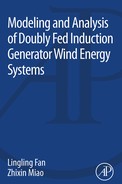Book Description
Wind Energy Systems: Modeling, Analysis and Control with DFIG provides key information on machine/converter modelling strategies based on space vectors, complex vector, and further frequency-domain variables. It includes applications that focus on wind energy grid integration, with analysis and control explanations with examples.
For those working in the field of wind energy integration examining the potential risk of stability is key, this edition looks at how wind energy is modelled, what kind of control systems are adopted, how it interacts with the grid, as well as suitable study approaches.
Not only giving principles behind the dynamics of wind energy grid integration system, but also examining different strategies for analysis, such as frequency-domain-based and state-space-based approaches.
- Focuses on real and reactive power control
- Supported by PSCAD and Matlab/Simulink examples
- Considers the difference in control objectives between ac drive systems and grid integration systems
